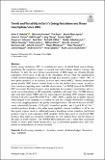Trends and Variability in Earth’s Energy Imbalance and Ocean Heat Uptake Since 2005
Author(s)
Hakuba, Maria Z.; Fourest, Sébastien; Boyer, Tim; Meyssignac, Benoit; Carton, James A.; Forget, Gaël; Cheng, Lijing; Giglio, Donata; Johnson, Gregory C.; Kato, Seiji; Killick, Rachel E.; Kolodziejczyk, Nicolas; Kuusela, Mikael; Landerer, Felix; ... Show more Show less
Download10712_2024_Article_9849.pdf (7.892Mb)
Publisher with Creative Commons License
Publisher with Creative Commons License
Creative Commons Attribution
Terms of use
Metadata
Show full item recordAbstract
Earth’s energy imbalance (EEI) is a fundamental metric of global Earth system change, quantifying the cumulative impact of natural and anthropogenic radiative forcings and feedback. To date, the most precise measurements of EEI change are obtained through radiometric observations at the top of the atmosphere (TOA), while the quantification of EEI absolute magnitude is facilitated through heat inventory analysis, where ~ 90% of heat uptake manifests as an increase in ocean heat content (OHC). Various international groups provide OHC datasets derived from in situ and satellite observations, as well as from reanalyses ingesting many available observations. The WCRP formed the GEWEX-EEI Assessment Working Group to better understand discrepancies, uncertainties and reconcile current knowledge of EEI magnitude, variability and trends. Here, 21 OHC datasets and ocean heat uptake (OHU) rates are intercompared, providing OHU estimates ranging between 0.40 ± 0.12 and 0.96 ± 0.08 W m−2 (2005–2019), a spread that is slightly reduced when unequal ocean sampling is accounted for, and that is largely attributable to differing source data, mapping methods and quality control procedures. The rate of increase in OHU varies substantially between − 0.03 ± 0.13 (reanalysis product) and 1.1 ± 0.6 W m−2 dec−1 (satellite product). Products that either more regularly observe (satellites) or fill in situ data-sparse regions based on additional physical knowledge (some reanalysis and hybrid products) tend to track radiometric EEI variability better than purely in situ-based OHC products. This paper also examines zonal trends in TOA radiative fluxes and the impact of data gaps on trend estimates. The GEWEX-EEI community aims to refine their assessment studies, to forge a path toward best practices, e.g., in uncertainty quantification, and to formulate recommendations for future activities.
Date issued
2024-07-29Department
Massachusetts Institute of Technology. Department of Earth, Atmospheric, and Planetary SciencesJournal
Surveys in Geophysics
Publisher
Springer Netherlands
Citation
Hakuba, M.Z., Fourest, S., Boyer, T. et al. Trends and Variability in Earth’s Energy Imbalance and Ocean Heat Uptake Since 2005. Surv Geophys (2024).
Version: Final published version